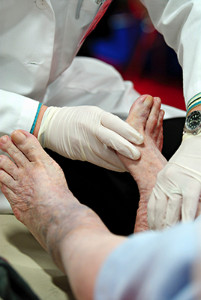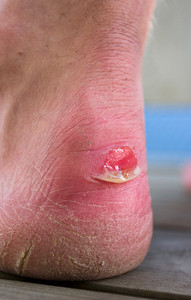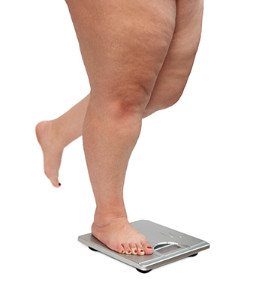 Diabetes is often the underlying condition behind a myriad of foot and ankle problems. Issues such as peripheral neuropathy, in which a patient experiences a tingling or burning sensation in the feet, and poor circulation in the legs and feet both have links to diabetes. To avoid the injuries often associated with diabetes, consider the following guidelines: wear properly fitting shoes that offer support, inspect the feet often for bruises and cuts, trim the toenails regularly, dry the feet thoroughly after bathing, avoid using heating pads or hot water bottles on the feet, exercise gently to increase circulation and muscle tone, and alert your podiatrist immediately upon spotting an injury, blister, or lesion.
Diabetes is often the underlying condition behind a myriad of foot and ankle problems. Issues such as peripheral neuropathy, in which a patient experiences a tingling or burning sensation in the feet, and poor circulation in the legs and feet both have links to diabetes. To avoid the injuries often associated with diabetes, consider the following guidelines: wear properly fitting shoes that offer support, inspect the feet often for bruises and cuts, trim the toenails regularly, dry the feet thoroughly after bathing, avoid using heating pads or hot water bottles on the feet, exercise gently to increase circulation and muscle tone, and alert your podiatrist immediately upon spotting an injury, blister, or lesion.
Diabetic foot care is important in preventing foot ailments such as ulcers. If you are suffering from diabetes or have any other concerns about your feet, contact one of our podiatrists from Canonsburg Podiatry Associates. Our doctors can provide the care you need to keep you pain-free and on your feet.
Diabetic Foot Care
Diabetes affects millions of people every year. The condition can damage blood vessels in many parts of the body, especially the feet. Because of this, taking care of your feet is essential if you have diabetes, and having a podiatrist help monitor your foot health is highly recommended.
The Importance of Caring for Your Feet
- Routinely inspect your feet for bruises or sores.
- Wear socks that fit your feet comfortably.
- Wear comfortable shoes that provide adequate support.
Patients with diabetes should have their doctor monitor their blood levels, as blood sugar levels play such a huge role in diabetic care. Monitoring these levels on a regular basis is highly advised.
It is always best to inform your healthcare professional of any concerns you may have regarding your feet, especially for diabetic patients. Early treatment and routine foot examinations are keys to maintaining proper health, especially because severe complications can arise if proper treatment is not applied.
If you have any questions please feel free to contact our office located in Canonsburg and McMurray, PA . We offer the newest diagnostic and treatment technologies for all your foot and ankle needs.


